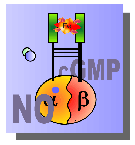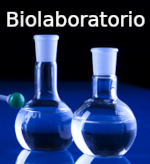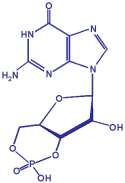
© Blauplanet.com
Other sections:





Cyclic GMP
Site
Created by Dr. Luis Agulló (last update on 28-12-2007)
Introduction to Signal Transduction
Fig. 1. An example of signal transduction cascades. Extracellular signals (hormones, neurotransmitters,.) reach the cell membrane and interact with specific receptors. Then, changes in the tridimensional structure of the receptor takes place and in this new state it is able to induce the activation of an enzyme that produces other signal molecules in the intracellular face of the membrane. Finally, these compounds, named second messengers, evoke different changes in the cell.
As commented before in the PRESENTATION, cells have developed mechanisms to be aware of extracellular alterations.
Cell Transduction Systems: Receptors and Second Messengers
Frequently in the cell membrane and sometimes in other locations, cells have receptors. Receptors are complex molecules that interact specifically with certain substances of the environment. After binding to these substances (e.g. hormones), receptors suffer an alteration of its tridimensional structure that results in changes in the concentration of certain molecules inside the cells, second messengers, that mediate the final response of the cells to the environmental modification previously detected by receptors. Sometimes, receptors themselves have the capacity of synthesize second messengers, but frequently other complex molecules that interact with receptors are needed for the production of those molecules.
Related Web Sites


Author: Dr. Luis Agulló (luis.agullo [at] lagullo.com).
Edited by Blauplanet.com, Cerdanyola del Vallès, Barcelona, Spain.
Webmaster: info [at] blauplanet.com. Conditions of use.